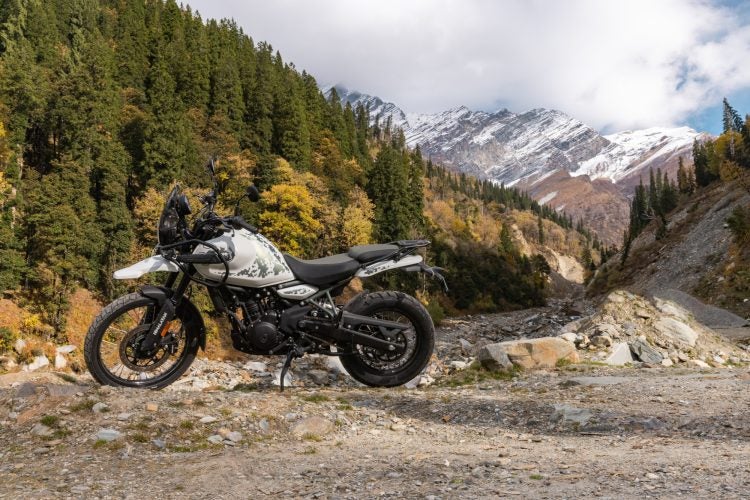A few weeks back, Ryan Adams, the resident good guy/big boss/ADVer at Motorcycle.com got a chance to test the Royal Enfield Himalayan 450 in its home environment—the mountains of India. Sure sounds like fun, although the thought of the jet lag alone is enough to give oldsters like me the heebie-jeebies.
Anyway, Ryan’s whole review is up at Motorcycle.com now. You can see it here, with some quick comments in his video summary underneath here.
But if you just want a quick overview of the bike, here are the basic details, and you can check out the photo gallery below.
The new 450 is a liquid-cooled single-cylinder engine, with about 40 hp and 29.5 lb-ft of torque. A six-speed gearbox is standard, and electronic fuel injection (a big bonus in the mountains). It’s in an all-new chassis, not a recycled version of the old air-cooled Himalayan. Tubeless spoked rims are available. The centerstand is standard equipment. The bike comes with two ride modes and switchable ABS. Seat height is adjustable in the 31.7 to 32.5 in range. Wet weight is a claimed 432 lb.
Unfortunately, we don’t know North American pricing or availability for sure. We would expect the machine to show up in mid-2024 at a price between $6500 and $7500 USD, especially depending which variant you buy (there are three options, depending if you want fancy paint or other farkles). However, it does seem that despite the many updates to the bike, Royal Enfield wants to keep pricing affordable. More details on that when we get them. Otherwise, see a summary of Ryan’s story below:
- “Capable but not intimidating.” That’s Royal Enfield’s summary of the Himalayan series, and Ryan says it still applies to the new bikes. They can haul you for long hard miles, and they did on this trip, but they’re still a bike a newbie shouldn’t find excessively scary. Photo: Royal Enfield
- Tilting the engine forward allowed for a change in weight bias, to the front of the bike. A dry sump allows for more ground clearance. The fork and shock are from Showa, and non-adjustable, but much better than the previous model. Photo: Royal Enfield
- Brakes are also much better, says Ryan, although they’re still pretty basic. He found the ABS system a little too touchy off-road, intervening more than he’d like, but it was manageable. Photo: Royal Enfield
- A 21-17 wheelset, just like your trusty DR650 and KLR. Ryan’s test bike came with tube-type tires. Photo: Royal Enfield
- That new circular TFT can be paired with a smartphone for GPS mapping purposes, moving your bike’s important info down to the bottom half while the top of screen shows your nav. Photo: Royal Enfield
- The engine has more zip than the old air-cooled Himi, but Ryan points out that the mountains still are a tough place to do an intro for a 450. But this engine isn’t made for throttle-up wheelies at high altitude; it’s made to get you to your destination reliably, and it achieved that goal on the trip. Ryan’s looking forward to testing one at sea level soon. Photo: Royal Enfield
- New LED lights to match the rest of the more modern looks. And of course, along with those crash bars seen here, you can add luggage racks and many other farkles. Photo: Royal Enfield
- A bolt-on subframe is good news for ADVers who like to head off-road. The frame is a steel twin-spar arrangement, and the engine is a stressed member of the chassis. Overall, a much better package than the previous Himalayan. Photo: Royal Enfield
- A neutral riding position whether riding or standing, although the seat height has risen an inch on this model. Photo: Royal Enfield
- All in all, a machine that’s advanced considerably from the OG Himalayan. But will all the changes drive the price up significantly, and scare off business? We won’t know ’til we see the US MSRP… Photo: Royal Enfield
See the whole MO review here.

















